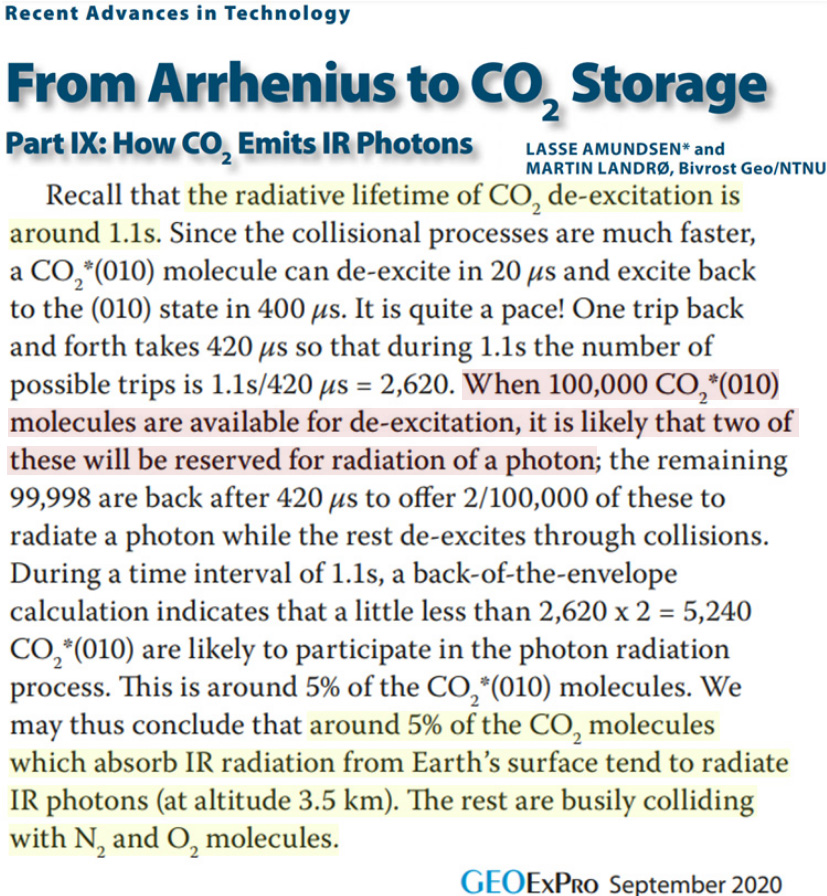Examining the beliefs underpinning the assumption that humans are heating up the planet can be enlightening.
A book focusing on CO2 storage has recently been published by two geophysicists (Amundsen and Landro, 2023).
Using insights from Svante Arrhenius, the late 19th century founding “father of climate change,” the authors assess that the radiative lifetime of CO2 de-excitation in the atmosphere is about 1.1 seconds. During this time span (1.1 seconds), an estimated 2,620 collisions with N2 and O2 molecules occur.
Nearly all – 99,998 out of every 100,000 – CO2 molecules do not radiate photons, but instead re-excite through collisions. Just 2 of 100,000 CO2 molecules radiate photons.
Of the CO2 molecules that absorb infrared energy from the Earth’s surface, about 1 of every 20 (5%) participate in the photon radiation process about 3-4 km above the surface.
So, if the CO2 concentration in the atmosphere has increased by 1 part in 10,000 since 1950 (0.032% to 0.042%), and even if 100% of this one-one-hundredths of a percentage point change is due to human activity, it still can be said that humans have had a vanishingly small impact on the atmospheric CO2 radiation process.






[…] Related: New Research: Only 2 Of Every 100,000 CO2 Molecules Radiate Photons. And This Controls Climate? […]
More importantly, the percentage of CO2 in the atmosphere is about 0.03%. This makes the meme of CO2 as a problem, pointless.
Yong Tuition shows that a maximum of 10% can be absorped by CO2. I think that is if every molecule absorbs
I seem to remember someone pseudonymously named ‘LOL@Klimate Katastrophe Kooks’ who stated exactly this… that CO2 is a dual-role molecule, dependent upon temperature… at lower temperatures, more thermalization occurs; at higher temperatures, more radiation emission occurs… that the CO2 molecule can just as easily gain energy via t-v (translational-to-vibrational mode) collision as it can lose that energy via v-t (vibrational-to-translational mode) collision… that the combined kinetic energy of two colliding atoms or molecules is, on average, always very near the ‘average’ atmospheric temperature… that that fact is the reason that the atmosphere ‘averages out’ to ~287.64 K… that it is the aggregate of the vibrational mode quantum state and the kinetic energy of all atmospheric constituents which set that ‘average’ temperature, and the atmosphere strives to oscillate about that mean.
That individual was attacked… first by the warmist trolls, then by Jo Nova’s moderator minions in the stead of the warmist trolls, then by Jo Nova herself.
We used to simply call this excited state quenching.
Presumably this will increase the kinetic energy and temp of the surrounding air N2/O2 and have some effect?
Indeed, and this is called thermalization.
According to the NASA (2009) Earth energy budget, CO2 and H2O absorb 17W/m² in the lower troposphere from the surface.
The same Energy budget from NASA 2009 shows that those same active gases in the IR spectrum emit 170W/m² into space from the middle troposphere and upwards.
The atmospheric convection cells constantly transfer heat from the warmed low to middle troposphere (197W/m² by evaporation/condensation (85W/m²), conduction/convection (17W/m²), radiation absorbed from the surface (17W/m²) and from the sun (78W/m²)) to the cooled middle to high troposphere (170W/m² emitted by IR active gases into space and 27W/m² emitted by clouds into space).
Thus, calling IR active gases “greenhouse gases” is all but correct.
They should rather be called AC gases, since :
– they allow the atmosphere to transfer energy into space,
– this tranfer is an increasing function of the absorbed energy from the surface and the sun.